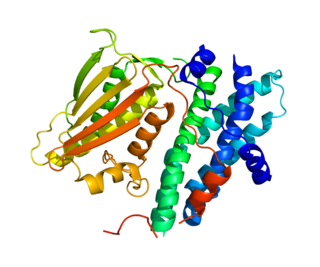
Pyruvate dehydrogenase lipoamide kinase isozyme 1, mitochondrial is an enzyme that in humans is encoded by the PDK1 gene. It codes for an isozyme of pyruvate dehydrogenase kinase (PDK).

The Von Hippel–Lindau tumor suppressor also known as pVHL is a protein that, in humans, is encoded by the VHL gene. Mutations of the VHL gene are associated with Von Hippel–Lindau disease, which is characterized by hemangioblastomas of the brain, spinal cord and retina. It is also associated with kidney and pancreatic lesions.

Hypoxia-inducible factor 1-alpha, also known as HIF-1-alpha, is a subunit of a heterodimeric transcription factor hypoxia-inducible factor 1 (HIF-1) that is encoded by the HIF1A gene. The Nobel Prize in Physiology or Medicine 2019 was awarded for the discovery of HIF.

Hypoxia-inducible factor 3 alpha is a protein that in humans is encoded by the HIF3A gene.

Probable G-protein coupled receptor 45 is a protein that in humans is encoded by the GPR45 gene.

Diamine acetyltransferase 1 is an enzyme that in humans is encoded by the SAT1 gene found on the X chromosome.

Egl nine homolog 2 is a protein that in humans is encoded by the EGLN2 gene. ELGN2 is an alpha-ketoglutarate-dependent hydroxylase, a superfamily of non-haem iron-containing proteins.

Hypoxia-inducible factor prolyl hydroxylase 2 (HIF-PH2), or prolyl hydroxylase domain-containing protein 2 (PHD2), is an enzyme encoded by the EGLN1 gene. It is also known as Egl nine homolog 1. PHD2 is a α-ketoglutarate/2-oxoglutarate-dependent hydroxylase, a superfamily non-haem iron-containing proteins. In humans, PHD2 is one of the three isoforms of hypoxia-inducible factor-proline dioxygenase, which is also known as HIF prolyl-hydroxylase.

Glutamate-cysteine ligase regulatory subunit is an enzyme that in humans is encoded by the GCLM gene.

N-alpha-acetyltransferase 10 (NAA10) also known as NatA catalytic subunit Naa10 and arrest-defective protein 1 homolog A (ARD1A) is an enzyme subunit that in humans is encoded NAA10 gene. Together with its auxiliary subunit Naa15, Naa10 constitutes the NatA complex that specifically catalyzes the transfer of an acetyl group from acetyl-CoA to the N-terminal primary amino group of certain proteins. In higher eukaryotes, 5 other N-acetyltransferase (NAT) complexes, NatB-NatF, have been described that differ both in substrate specificity and subunit composition.

Egl nine homolog 3 is a protein that in humans is encoded by the EGLN3 gene. ELGN3 is a member of the superfamily of alpha-ketoglutarate-dependent hydroxylases, which are non-haem iron-containing proteins.

Polyamine-modulated factor 1 is a protein that in humans is encoded by the PMF1 gene.

Chromatin modification-related protein MEAF6 is a protein that in humans is encoded by the MEAF6 gene.

Homer protein homolog 2 is a protein that in humans is encoded by the HOMER2 gene.

Aryl hydrocarbon receptor nuclear translocator 2 is a protein that in humans is encoded by the ARNT2 gene.

Spermine synthase is an enzyme that in humans is encoded by the SMS gene. The protein encoded by this gene belongs to the spermidine/spermine synthases family. This gene encodes a ubiquitous enzyme of polyamine metabolism.

E74-like factor 2 (ELF2), formerly known as new Ets-related factor (NERF), is an ETS family transcription factor. In humans this protein is encoded by the ELF2 gene.

Peroxisomal N(1)-acetyl-spermine/spermidine oxidase is an enzyme that in humans is encoded by the PAOX gene.

RWD domain-containing protein 3 is a protein that in humans is encoded by the RWDD3 gene.

In molecular biology, TAZ zinc finger domains are zinc-containing domains found in the homologous transcriptional co-activators CREB-binding protein (CBP) and the P300. CBP and P300 are histone acetyltransferases that catalyse the reversible acetylation of all four histones in nucleosomes, acting to regulate transcription via chromatin remodelling. These large nuclear proteins interact with numerous transcription factors and viral oncoproteins, including p53 tumour suppressor protein, E1A oncoprotein, MyoD, and GATA-1, and are involved in cell growth, differentiation and apoptosis. Both CBP and P300 have two copies of the TAZ domain, one in the N-terminal region, the other in the C-terminal region. The TAZ1 domain of CBP and P300 forms a complex with CITED2, inhibiting the activity of the hypoxia inducible factor (HIF-1alpha) and thereby attenuating the cellular response to low tissue oxygen concentration. Adaptation to hypoxia is mediated by transactivation of hypoxia-responsive genes by hypoxia-inducible factor-1 (HIF-1) in complex with the CBP and p300 transcriptional coactivators.





















